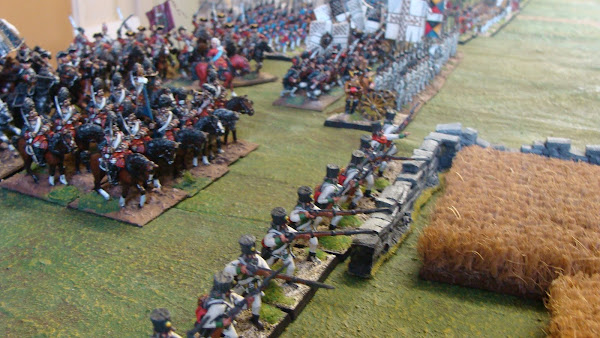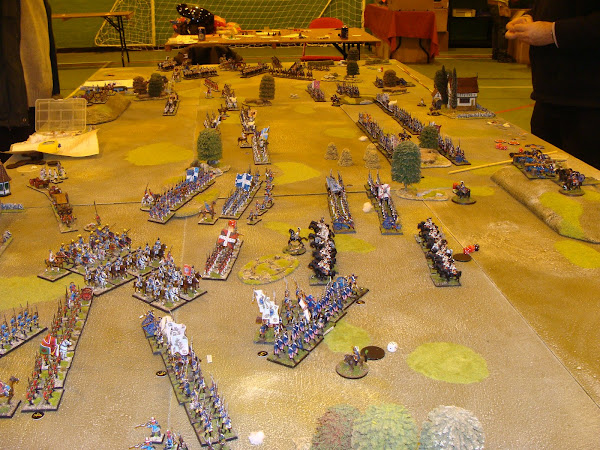Eagl eyed viewers will spot the Tardis in the grounds of the churchyard, unfortunately it didn't help Charles fight any better.
Its a funny old game,...wargaming. One minute you're up there, the second its dragging you down, buts that's enough of cliches. Blackpowder as a set of rules certainly knows how to kick one in the cods, as witnessed in the refight of the Battle of Leuthen, yesterday. Again I will leave the account to Colin who organised the whole affair, and should take credit for a first class battle.
I actually volunteered for command of the Austrian's, realising that their commanders did not perform very well on the day, especially the Commander in Chief, Charles of Lorraine, who really should have been shot after the real battle, but titles have their privileges.
Anyway two things were thrown up during the refight using Blackpowder, both were very important to the battle from both sides point of view. One was traversing fire by artillery and the second was the ability of Prussian field guns being able to manhandle forward and fire in the same move. Neither are items mentioned in the rules as being no no's, however neither sat well the the Austrian commanders, probably because we were getting shot to pieces by the said guns. Personally I dont think you can do either, but I am biased. Still the game fought out well, albeit the Austrians and especially my commands collapsed like a deck of cards. I wait in anticipation for the decision by Sepp Blatter as to an official ruling on the Warlord website. In the meantime its fair to say that the Prussian army and Blackpowder are not flavour of the month. Now where are those Frostgrave plastic figures?

The Independent Wargames Group. Being a Journal of views, prejudices, ideas and photographs of wargaming not just nationwide, but hopefully world wide. The name IWG was adopted in the early 1980's in response to the then dominant Wargames Research Group, but things have moved on, and wargaming appears to be in somewhat of a Golden Age, so sit back and hopefully enjoy my rantings.
Subscribe to:
Post Comments (Atom)
My 6mm Napoleonic set up.

Austria 1809.
Austrian Hussars

Hinchliffe figures
Austrian Grenzer

Austrian Grenzer
Smoggycon 2013

Smoggycon 2013
Smoggycon 2012

Smoggycon 2012
Smoogycon 2009

My French getting another beating






Robbie,
ReplyDeleteThe account from the Prussian side does give some credit to the valiant effort of the Austrians. but history is written by the victors as they say.
As for Black powder - manhandling and firing of artillery for me comes down to calibre. The bigger the gun the harder it is to move. The small 3pdr pieces were nimble even fifty years earlier when Blood does his work at Blenheim. Not sure about traversing fire either. artillery this point were more point and shoot weapons and not able to track a target. My understanding was that a good gunner had to rely on locating the fall of his previous shot to determine what adjustments to make for the next (and all that after having to relocate the gun from the roll back caused by the recoil of the previous shot).
are you joining me in disliking BP now then?
I actually agree that artillery doing traversing fire is probably a no-no, but if a unit strolls past a battery of guns representing 20+ real pieces at point blank range then there is an argument that the gunners might well take a shot. As for manhandling and moving, the rules state that the guns (not v heavy ones) can move once in the movement phase and fire in the shooting phase. Whatever the pro's and con's BP make for a good game if used with common sense and a feeling for the period (IMHO). I must try again to tempt you out of the light into the dark side....
DeleteColin, I'll play Black powder. Hell I'll play most rules sets if it gets me a game with friends played in a good atmosphere. But like most medicines - don't expect me to like it.
DeleteI''m still not convinced about traversing fire, which is different to passing fire. Passing fire implies that the firer was already pointing in the direction of the target and took an opportunistic shot. traversing implies that the target was tracked as it moved. Opportunistic firing should be at a disadvantage because the firer (especially artillery) hasn't had the time to prepare his guns. little less important when firing canister of course which doesn't need laying down, definitely a point and shoot ammunition.
Great. Me too, except perhaps any of the DB? rules.
DeleteWhat the rules call traversing fire is actually opportunistic passing fire. Agreed there should be a disadvantage to the firer.
Afternoon Paul,
DeleteIts good to see you've entered the debate! about traversing fire. Blackpowder doesn't actually mention artillery in the example given, but talks about infantry and this is where the friction is. I was quite neutral on this until our refight of Leuthen, where my cavalry had to ride past a battery of Prussian guns that had just manhandled onto my flank. So there were two things for me. Should a field gun be able to move, and then fire? and should the battery then be able to traverse fire?.
Paul was allowed to do so, but managed to miss completely, by throwing three ones, which then led to another small debate, because in the later Pike and Shot rules, putting a battery together suffers a penalty if two ones are thrown when they fire. A gun is actually put out of action. The move was actually key to the whole game, because I lost the melee, and because of the brigade exhaustion rule, I had reached the limit and lost the battle.
So to answer your question YES, I sometimes do dislike Blackpowder, but by the same token, we fought the battle to its conclusion, and it was very exciting, so one shouldnt complain too much. It was a great way to spend an afternoon.
Tracking- or traversing 18th century artillery was hardly possible at all - certainly for anything above a light piece. Its about weight of the piece and the number of gunners (and the ground it you want to factor that in.) Its also about training and doctrine. Personally I'm not actually convinced that "artillery of position " -as distinct from battalion guns should be able to move much at all once set up and switching targets would also take time - especially if several guns firing as a battery. If a model gun represents several guns its going to take an age to traverse them any distance-keeping battery integrity and line etc. Most rules I've come across for almost any black powder period allow guns too much freedom of movement- this is most obviously true for pre-Napoleonic eras
ReplyDeleteNot the same period but I've been reading a lot on the Spanish Succession lately and certainly they seem to agree what you say... artillery then, may be not so much in the SYW, was definitely far more static with the exception of the light stuff as Paul mentioned above...
DeleteAfternoon Andy,
DeleteI have always worked on the principle, that until the Revolutionary and Napoleonic Wars, artillery was pretty static, apart from battalion guns, which were exactly what they were. But in Blackpowder, there isn't a definitive answer, and whilst that shouldn't be a problem, Leuthen certainly flagged up how powerful manhandled guns can be.
Perhaps if the Austrians had had guns, then I wouldnt be chuntering on.
Steve, as for the Malburian period, I have always played that once a battery is deployed it cannot move again, this was to highlight the civilian status of the persons who brought the guns to the battlefield. They usually and rightly buggered off once the balls began to fly. I do remember that they were made to stay in one battle and drag some guns forward, but that was after some grenadiers threatened to skewer them with their bayonets. That was an exception though.
Yes, but its a shame the Austrians had to leave almost all their artillery behind including battalion guns, when they raced south a few km to fend off the Prussian attack. The effect of the guns in our refight was about on a par with in the historical event, and in trying to reflect the fact that Fred pushed his guns, heavies and all, up with the infantry to smash the poor Austrians, it seemed right on this occasion to allow most of them to be manhandled once and fire as per the rules. Also, FtG had several hundred unmounted dragoons who were pressed in as gun pullers/draggers. There are plenty of instances where the Prussians moved/redeployed their artillery once battle had commenced (quite some distance at Zorndorf) so the trick is to reflect this fairly in the game.
DeleteIm surprised the little bugger didnt draft in some local peasants to drag the guns, given his nature.
DeleteStill it was hard to take, but a great game even so.
Colin- not being a fan of Frederick the Average I can't comment on the Prussian army per se but I'd ask which guns were moved and what type they were. There are not usually enough distinctions in rules regarding artillery- check our Hughes. Also there were some distinctions between guns of the "same" type- I've seen references to "light" 4pdr and 6 pdr guns- which seems to refer to carriages as much as anything also "long" and "short" guns of various weights. In Game terms its mostly about which fudges you are prepared to put up with and which not . Using Dragoons as gun mules probably wouldn't have worked in any other army . Certainly not the British probably not the French
DeleteAndy, the vast majority of Fred's field guns were 12pdrs and accounts tell of them moving up with the infantry throughout the battle of Leuthen. Indeed they are reported to have limbered up and moved during Rossbach and Zorndorf to name two examples so I think the idea of universally static artillery for the SYW is a little too general. Either way, we played it the way we did as the rules permitted it, that being the BP works. In our game there was no issue over a battery representing 12 real cannon from changing face which would be a major effort in itself not too dissimilar to manhandling forwards. I'm beginning to reconsider my view regarding traversing or really opportunistic fire somewhat.
Delete